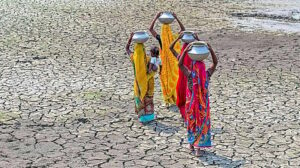
A new study has warned that by 2030, cities like Mumbai, Chennai, Delhi, Surat, Thane, Hyderabad, Patna, and Bhubaneswar will see a two-fold rise in heatwave days, worsening the already severe risks from climate change. The report, released on June 10, 2025, by IPE Global and GIS technology leader Esri India, highlights the alarming future facing India’s urban centres as temperatures soar and extreme weather events become more frequent.
The study Weathering the Storm: Managing Monsoons in a Warming Climate was unveiled at the International Global-South Climate Risk Symposium in New Delhi. It offers detailed district-level assessments of how erratic rainfall and extreme heat are intensifying across India, putting both urban and rural regions at risk.
One of the report’s most striking findings is that 8 out of 10 districts in India will see a sharp rise in irregular, heavy rainfall, increasing the likelihood of floods, crop failures, and infrastructure damage. Coastal districts are expected to fare even worse, with 69% likely to suffer from prolonged heat stress during monsoon months a figure that could climb to 79% by 2040.
“About 72% of tier-I and tier-II cities will face more heat stress, heavy rains, storm surges, lightning, and hailstorms,” said Abinash Mohanty, lead author of the study. He also warned that global weather systems such as El Nino and La Nina are strengthening, adding more unpredictability to India’s climate. “This will result in sudden spikes in extreme weather floods, cyclones, and intense heat,” Mohanty explained.
Microclimate Shifts, Land-Use Changes Worsening the Situation
The study traced the rise in heat to changing land-use patterns. As forests turn into farmlands and wetlands become housing colonies, local climates lose their natural cooling systems. In a ‘business-as-usual’ scenario, 63% of India’s hotspot districts will experience land-use changes by 2030, worsening both heatwaves and unpredictable rainfall.
States already struggling with extreme temperatures — Gujarat, Rajasthan, Tamil Nadu, Odisha, Uttarakhand, Himachal Pradesh, Maharashtra, Uttar Pradesh, Meghalaya, and Manipur — are also projected to face extreme rainfall, putting nearly 80% of their districts at risk.
“Unplanned urban growth, deforestation, and loss of wetlands and mangroves are making these problems worse,” warned Mohanty. He stressed the need for hyper-local risk assessments and climate observatories to protect critical sectors like farming, industry, and large-scale infrastructure from climate shocks.
Heatwaves: No Longer Rare, But Routine
India’s heatwaves are already intensifying. Between 1993 and 2024, the country saw a 15-fold jump in heatwave days, and the last decade alone recorded a 19-fold increase. These scorching spells are not only harming public health but also raising electricity demand, depleting water resources, and slashing farm productivity.
“The growing intensity and frequency of these weather extremes are no longer rare. They are becoming the new normal,” said Agendra Kumar, Managing Director of Esri India. He added that GIS technology could help cities, farms, and disaster agencies monitor and manage these risks in real-time, using dynamic data to plan smarter responses.
The Way Forward: Data, Funding, Local Action
The authors of the study are urging India to establish a Climate Risk Observatory, a national platform that can use satellite data and climate models to forecast risks and guide timely action. They also recommend setting up heat-risk champions in every district to lead local disaster responses and improve community preparedness.
In addition, they called for risk financing tools to help governments and businesses absorb economic shocks from climate disasters.
Ashwajit Singh, founder of IPE Global, pointed out that developing countries like India face a dual challenge — improving living standards while bracing for worsening climate impacts. “To lead the world as a climate solutions hub, India must bring its innovations from the margins into the mainstream,” Singh said.
The report comes just as India prepares for the UN climate negotiations in Bonn (SB 62), where nations will review progress and gaps in climate action. The study calls for India to adopt a “climate solutions mindset” shifting from reacting to disasters to proactively planning for a hotter, wetter, and more uncertain future.
